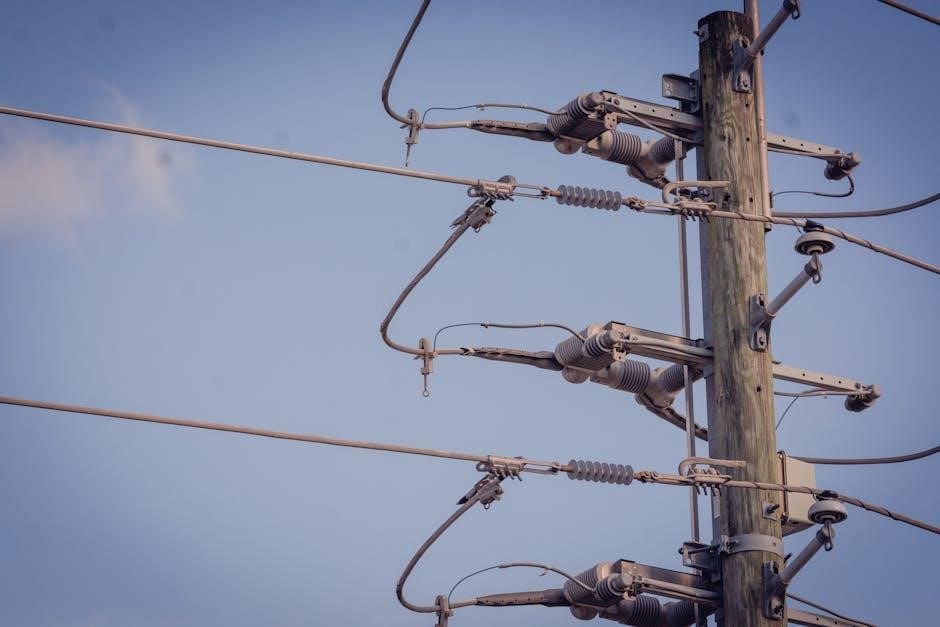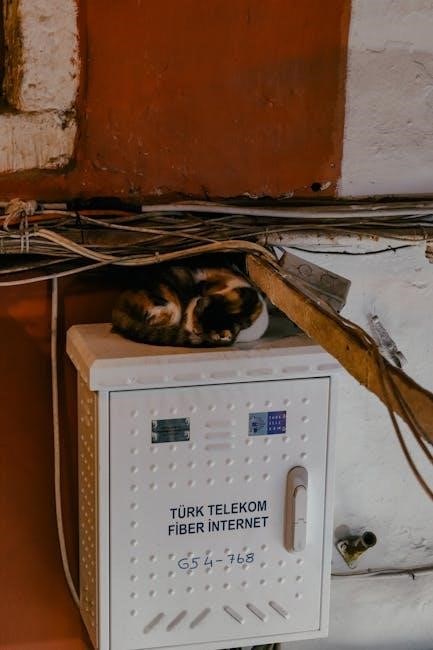An electric scooter wiring diagram PDF is a detailed guide illustrating the electrical connections and components of an e-scooter. It ensures safe, compatible, and efficient troubleshooting and maintenance, serving as a crucial resource for DIY enthusiasts and professionals alike. This comprehensive visual aid simplifies complex electrical systems, making it easier to understand and work with your scooter’s wiring.
1.1 Importance of Wiring Diagrams for Electric Scooters
Wiring diagrams are essential for understanding and maintaining an electric scooter’s electrical system. They provide a clear visual representation of connections, ensuring safety and preventing damage. These diagrams are crucial for troubleshooting issues like short circuits or faulty components. They also guide proper installation and upgrades, helping users avoid dangerous electrical hazards. By following a wiring diagram, enthusiasts can maintain their scooter’s performance and longevity, making it an indispensable tool for both DIY projects and professional repairs.
1.2 Brief Overview of Electric Scooter Electrical Systems
An electric scooter’s electrical system comprises a motor, controller, battery, and wiring that connects these components. The wiring diagram PDF illustrates how these parts interact, such as the throttle controlling the motor and the brake system ensuring safety. Sensors monitor speed and battery levels, while lighting and indicators enhance visibility. Understanding this system is crucial for troubleshooting and maintenance, ensuring optimal performance and longevity of the scooter.

Understanding Electric Scooter Wiring Diagrams
A wiring diagram is a visual representation of an electric scooter’s electrical system, showing connections between components like the motor, controller, and battery. It helps in troubleshooting and installing electrical systems by providing a clear, concise overview of how electricity flows through the scooter’s circuitry.
2.1 Key Components of a Wiring Diagram
A wiring diagram for an electric scooter typically includes key components such as the motor, controller, battery, throttle, brake sensors, lighting systems, and battery management system (BMS). These elements are represented visually, showing how they connect and interact within the electrical circuit. The diagram also highlights essential parts like switches, fuses, and wiring harnesses, providing a clear overview of the scooter’s electrical layout. Understanding these components is crucial for troubleshooting, repairs, and customizations, ensuring the scooter operates safely and efficiently. The diagram acts as a roadmap for diagnosing and resolving electrical issues.
2.2 Symbols and Notations Used in Wiring Diagrams
Wiring diagrams for electric scooters use standardized symbols and notations to represent components and connections. Common symbols include circles for switches, rectangles for controllers, and stylized shapes for motors and batteries. Lines represent wires, with arrows indicating current flow. Colors may denote different circuits or voltages. Abbreviations like “BMS” for Battery Management System are often used. These symbols ensure clarity, making diagrams universally understandable. They are essential for identifying components, tracing circuits, and diagnosing issues efficiently; Proper interpretation of these symbols is crucial for safe and effective electrical work on the scooter.
2.3 How to Read and Interpret Wiring Diagrams
Reading an electric scooter wiring diagram begins with identifying the components and their symbols. Start by locating the battery, controller, motor, and throttle, as these are central to the system. Trace the wires between components, noting connections and junctions. Use the key or legend provided to understand each symbol and line type. Pay attention to color coding, which often indicates live, neutral, or ground wires. Follow the flow of current from the battery through switches and components to the motor. Cross-reference with the component list to ensure all parts are accounted for. This systematic approach helps in troubleshooting and ensures safe modifications.

Components of an Electric Scooter Wiring System
An electric scooter’s wiring system includes the motor, controller, battery, BMS, throttle, brake sensors, and lighting. These components are interconnected to ensure efficient power distribution and safe operation.
3.1 Motor and Controller
The motor and controller are central to an electric scooter’s operation. The motor converts electrical energy into mechanical power, while the controller regulates energy flow from the battery to the motor. In a wiring diagram, these components are typically represented with distinct symbols, ensuring clear connections. Proper wiring between them is essential for optimal performance, safety, and efficiency. A well-detailed PDF diagram helps in understanding their integration, enabling enthusiasts to troubleshoot or upgrade their systems effectively. This setup ensures smooth acceleration and reliable braking mechanisms.
3.2 Battery and Battery Management System (BMS)
The battery is the power source of an electric scooter, while the BMS ensures its safe and efficient operation. The BMS monitors charge levels, prevents overcharging, and balances individual cells. In a wiring diagram, the battery and BMS are shown as critical components, with clear connections to the motor and controller. Proper wiring ensures reliable energy flow and protects against electrical hazards. A detailed PDF diagram helps in understanding these connections, enabling users to maintain, troubleshoot, or upgrade their scooter’s electrical system safely and effectively. This setup is vital for optimal performance and longevity.
3.3 Throttle and Speed Controller
The throttle and speed controller are essential components in an electric scooter’s wiring system. The throttle regulates power delivery to the motor, while the speed controller manages the scooter’s acceleration and velocity. In a wiring diagram, these components are typically connected to the battery, motor, and sometimes the BMS. Proper wiring ensures smooth control and safety. A well-detailed PDF diagram helps users understand how these parts interact, allowing for precise adjustments and troubleshooting. Incorrect wiring can lead to performance issues or safety hazards, making accurate connections crucial for reliable operation.
3.4 Brake System and Sensors
The brake system and sensors in an electric scooter are critical for safety and control. Wiring diagrams detail the connections between brake levers, sensors, and the controller. Sensors monitor braking activity, ensuring the motor responds appropriately. Proper wiring ensures reliable operation and safety. A PDF wiring diagram helps users trace connections, diagnose issues, and perform repairs. Incorrect wiring can lead to faulty braking, making accurate connections essential. The diagram also highlights how sensors integrate with other components, ensuring smooth interaction between braking and motor control systems for optimal performance and rider safety.
3.5 Lighting and Indicators
Lighting and indicators are essential for visibility, safety, and communication while riding an electric scooter. A wiring diagram PDF provides a clear layout of how lights, such as headlamps, taillights, and indicators, are connected to the electrical system. It details the wiring for brake lights, turn signals, and hazard lights, ensuring proper installation and functionality. The diagram also illustrates how these components integrate with the scooter’s controller and battery. Correct wiring ensures that all lights operate reliably, enhancing safety and compliance with traffic regulations. Regular inspection of these connections is vital to maintain optimal visibility and signaling capabilities while riding.

Installation and Setup of Electric Scooter Wiring
A step-by-step guide for installing and setting up electric scooter wiring ensures a safe and efficient process. Use a wiring diagram PDF to identify components and connections, ensuring all tools and materials are prepared. Properly securing wires and connectors is crucial to avoid short circuits. Always follow safety precautions, such as disconnecting the battery before starting work, to prevent electrical hazards.
4.1 Step-by-Step Guide to Wiring an Electric Scooter
Begin by referencing the electric scooter wiring diagram PDF to understand the layout and connections. Start by disconnecting the battery to ensure safety. Identify the key components such as the motor, controller, and battery. Connect the motor to the controller, ensuring proper polarity. Next, link the throttle and brake systems, followed by the lighting and indicators. Use wire strippers and crimpers for secure connections. Double-check all wiring for short circuits before reconnecting the battery. Finally, test the scooter at low power to verify functionality. This systematic approach guarantees a reliable and safe electrical setup.
4.2 Tools and Materials Required for Wiring
To successfully wire your electric scooter, gather essential tools like a multimeter, wire cutters, strippers, crimpers, and screwdrivers. Materials needed include high-gauge wires, connectors, heat shrink tubes, and electrical tape. Ensure you have a wiring diagram PDF specific to your scooter model for accurate guidance. Use fuses and relays to protect the circuit. Keep all components organized to avoid mismatches. Referencing the diagram, proceed methodically to ensure each connection is secure and correct, preventing potential electrical hazards.
4.3 Safety Precautions During Installation
When working with your electric scooter wiring diagram PDF, always disconnect the battery to prevent accidental power surges. Wear protective gear such as gloves and safety glasses. Ensure the scooter is on a stable, flat surface. Avoid overloading circuits, and verify each connection’s integrity. Keep flammable materials away and work in a well-ventilated area. Refer to the diagram for specific safety notes. Never bypass fuses or safety components. If unsure, consult a professional to prevent electrical hazards and ensure a safe, reliable installation.

Common Electric Scooter Wiring Issues
Common issues include short circuits, faulty components, and poor connectivity. Referencing a wiring diagram PDF helps diagnose and resolve these problems effectively for optimal scooter performance.
5.1 Identifying and Troubleshooting Common Problems
Common issues with electric scooter wiring include short circuits, faulty connections, and malfunctioning components. Using a wiring diagram PDF, you can trace connections and identify faults. Start by checking for loose wires or corrosion. Use a multimeter to test voltage and resistance. If a component fails, refer to the diagram to locate and replace it. Ensure compatibility with aftermarket parts to avoid system conflicts. Regular inspections and proper tools, like wire strippers, can prevent issues. Always follow safety guidelines to avoid electrical hazards during troubleshooting.
5.2 Fixing Short Circuits and Overheating Issues
Short circuits and overheating are common issues in electric scooter wiring. To fix these, start by identifying the source using a multimeter to test voltage and resistance. Inspect wires and connectors for damage or corrosion. Replace any faulty components and ensure proper insulation. Overheating often occurs due to excessive current or faulty BMS. Check the battery and motor connections, and verify that the wiring diagram aligns with your scooter’s specifications. Use heat-resistant materials and ensure good airflow. Always disconnect the battery before repairs and wear protective gear to avoid electrical hazards.
5.3 Diagnosing Faulty Components
Diagnosing faulty components in an electric scooter begins with consulting the wiring diagram to trace connections. Use a multimeter to test voltage, continuity, and resistance across circuits. Check for blown fuses or tripped circuit breakers. Inspect wires for cuts, frays, or corrosion. Test the battery voltage and ensure the BMS is functioning correctly. Verify motor and controller operation by comparing readings with the wiring diagram. Isolate and replace any components showing abnormal readings or physical damage. Always power down the scooter before testing to ensure safety and accurate results.

Safety Guidelines for Handling Electric Scooter Wiring
Always disconnect the battery before working on wiring to prevent electric shocks. Use insulated tools and wear protective gear like gloves and goggles. Ensure the area is dry to avoid short circuits. Never modify the wiring without proper knowledge or tools. Follow the wiring diagram guidelines to maintain safety and system integrity.
6.1 Precautions to Avoid Electrical Hazards
When handling electric scooter wiring, always disconnect the battery first to prevent electric shocks. Use insulated tools and wear protective gear like gloves and goggles. Ensure the work area is dry to avoid short circuits. Never attempt modifications without proper knowledge or tools. Follow the wiring diagram carefully to maintain safety and system integrity. Avoid overheating components and keep flammable materials away. Regularly inspect wiring for damage or wear. Ground yourself to prevent static discharge. If unsure, consult a professional to avoid risks.
6.2 Proper Use of Protective Gear
Always wear insulated gloves and goggles when handling electric scooter wiring to prevent electrical shocks and eye injuries. Use a fire-resistant mat to protect against sparks and spills. Ensure proper ventilation to avoid inhaling fumes from soldering or burning wires. Wear non-conductive footwear and avoid loose jewelry that could conduct electricity. Keep a fire extinguisher nearby and ensure all tools are insulated. Adhere to safety standards and consult a professional if uncertain. Proper protective gear ensures your safety while working with electrical systems, as outlined in most electric scooter wiring diagram PDFs.
6.3 Emergency Procedures for Electrical Incidents
In case of an electrical incident, immediately disconnect the battery to halt power flow. Use a fire extinguisher rated for electrical fires if a fire occurs. Never use water, as it can worsen the situation. If someone is shocked, turn off the power source before assisting. Wear protective gear to prevent further injury. After the incident, inspect the wiring and consult a professional to repair any damage. Always refer to your electric scooter wiring diagram PDF for guidance on safely managing electrical components and avoiding hazards.

Downloading and Using Electric Scooter Wiring Diagrams
Electric scooter wiring diagram PDFs are available for download from trusted sources, including manufacturer websites and forums. Use tools like Adobe Reader to access and view them.
7.1 Sources for Free PDF Downloads
Free electric scooter wiring diagram PDFs can be downloaded from manufacturer websites, forums, and dedicated resources. Websites like Wintekpower and Niu Technologies offer detailed diagrams. Additionally, platforms like SmartDraw provide tools to create or download customizable wiring schematics. Forums and communities, such as those for Segway or Nanrobot, often share user-contributed diagrams. Always verify the source’s reliability to ensure accuracy and safety. Using tools like Adobe Reader or specialized viewers is recommended for viewing these files. These resources are invaluable for troubleshooting and maintenance.
7.2 How to Verify the Accuracy of a Wiring Diagram
To verify the accuracy of an electric scooter wiring diagram PDF, start by cross-referencing it with the actual scooter components. Compare the diagram’s components with the manufacturer’s specifications and ensure they match the scooter’s model. Check for version numbers or dates to confirm it’s up-to-date. Obtain the diagram from official sources like manufacturer websites or trusted forums. Validate symbols against standard electrical notation and ensure clarity in the layout. Consult professionals or enthusiasts for confirmation, especially if unsure about specific details. This ensures the diagram is reliable for safe and effective use.
7.3 Software Tools for Viewing and Editing Wiring Diagrams
For viewing and editing electric scooter wiring diagram PDFs, tools like Adobe Acrobat Reader or Foxit Reader are essential. SmartDraw is a popular choice for creating and modifying diagrams, offering intuitive features. AutoCAD and Fritzing are advanced tools for detailed editing. Inkscape, a free vector graphics editor, can also edit PDF diagrams. These tools enable users to customize, annotate, or repair wiring diagrams, ensuring compatibility and clarity. Always use up-to-date software to maintain accuracy and functionality when working with electrical schematics.

Resources and References
Find electric scooter wiring diagram PDFs on trusted sites like Wintek Power, SmartDraw, and manufacturer-specific portals like Segway or Niu. Forums and technical communities also offer valuable resources.
8.1 Recommended Websites for Electric Scooter Wiring Diagrams
For reliable electric scooter wiring diagram PDFs, visit trusted sites like Wintek Power for BMS systems, SmartDraw for circuit design, and Scooter Manuals for specific models. Manufacturer websites such as Segway and Niu also provide official diagrams. Additionally, forums like Electric Scooter Parts and technical communities offer user-shared resources and troubleshooting guides, ensuring access to diverse wiring schematics and expert advice.
8.2 Manufacturer-Specific Wiring Diagrams
Manufacturer-specific wiring diagrams are tailored to particular electric scooter models, ensuring accuracy and compatibility; Brands like Segway, Niu, and Yamaha provide detailed schematics for their products. These diagrams are often found in official service manuals or on manufacturer websites. For models like the Nanrobot or Xiaomi Mi, diagrams may be accessed through authorized dealers or support portals. Always use manufacturer-specific diagrams for precise and reliable electrical system information to avoid compatibility issues and ensure safety during repairs or modifications.
8.3 Forums and Communities for Troubleshooting
Online forums and communities are invaluable for troubleshooting electric scooter wiring issues. Platforms like Reddit and specialized groups on Facebook offer spaces to share experiences and solutions. Websites like Instructables provide DIY guides, while forums dedicated to specific brands, such as Niu or Nanrobot, cater to model-specific issues. These communities often include wiring diagrams, error fixes, and expert advice, making them essential for resolving complex electrical problems and enhancing your scooter’s performance.

Maintenance Tips for Electric Scooter Wiring
Regularly inspect wiring and connectors for damage or corrosion. Clean electrical components with a soft brush or cloth. Apply protective sprays to shield against moisture and dust.
9.1 Regular Inspection of Wiring and Connectors
Regularly inspect wiring and connectors for signs of damage, corrosion, or wear. Use a multimeter to test for loose connections or short circuits. Check the battery terminals, motor connections, and controller wires. Consult your electric scooter wiring diagram PDF to ensure all components are properly connected. Clean connectors with a soft brush and apply a protective coating to prevent corrosion. Address any issues promptly to avoid electrical failures. Inspecting wiring regularly ensures optimal performance and safety, preventing costly repairs down the line. Always refer to your scooter’s wiring diagram for guidance.
9.2 Cleaning and Protecting Electrical Components
Clean and protect electrical components to ensure reliability and longevity. Use compressed air or a soft-bristled brush to remove dirt from connectors and wiring. Avoid harsh chemicals or water, which can damage components. Apply a corrosion-inhibiting spray or dielectric grease to protect terminals and connectors. Regular cleaning prevents short circuits and ensures proper conductivity. Refer to your electric scooter wiring diagram PDF for specific guidance on maintaining your scooter’s electrical system. Protecting components from environmental factors enhances performance and safety, ensuring your scooter operates at its best for years to come.
9.3 Upgrading or Replacing Wiring Components
Upgrading or replacing wiring components can enhance your electric scooter’s performance and safety. Always refer to your electric scooter wiring diagram PDF to identify the correct components and connections. Use high-quality, compatible wiring and connectors to avoid short circuits. When upgrading, ensure all components are rated for the scooter’s voltage and current. After installation, test the system thoroughly to confirm proper functionality. If unsure, consult a professional to avoid electrical hazards. Regular upgrades can prevent wear-related issues and ensure optimal performance. Proper replacement ensures reliability and extends the lifespan of your scooter’s electrical system.

Customization and Modification of Electric Scooter Wiring
Customizing your electric scooter’s wiring can enhance performance and functionality; Use a wiring diagram PDF to safely modify components like motors or controllers. Ensure compatibility and follow safety guidelines to avoid electrical issues.
10.1 Upgrading the Electrical System for Enhanced Performance
Upgrading your electric scooter’s electrical system can significantly boost performance. A wiring diagram PDF helps identify components like motors, controllers, and batteries for safe modifications. Consider high-quality wiring and connectors to prevent short circuits. Ensure compatibility when swapping components, such as upgrading to a more powerful motor or advanced BMS. Always follow safety guidelines and refer to manufacturer-specific guides for precise instructions. This approach ensures enhanced speed, torque, and efficiency while maintaining reliability and safety. Regularly inspect upgraded components to prevent overheating or electrical failures, ensuring optimal performance and longevity.
10.2 Adding Custom Features to Your Electric Scooter
A wiring diagram PDF is essential when adding custom features to your electric scooter, such as LED lighting, Bluetooth connectivity, or GPS. It helps identify the right connections for new components. Use high-quality wiring and connectors to ensure reliability. When installing features like regenerative braking or a customizable throttle, refer to the diagram to avoid short circuits. Always follow safety guidelines and test modifications gradually. This approach allows you to enhance functionality while maintaining your scooter’s performance and safety. Plan carefully to ensure compatibility and avoid electrical conflicts.
10.3 Ensuring Compatibility with Aftermarket Components
Using an electric scooter wiring diagram PDF helps ensure aftermarket components integrate seamlessly. Verify voltage and current ratings to match your scooter’s electrical system. Check connector types and wiring configurations for compatibility. Test installations gradually to avoid overloading circuits. Refer to manufacturer guidelines for specific components. This prevents electrical hazards and ensures optimal performance. Always prioritize compatibility to maintain safety and functionality when upgrading or customizing your scooter with aftermarket parts. Proper planning prevents potential malfunctions and enhances reliability.
11.1 The Importance of Proper Wiring for Optimal Performance
Proper wiring is crucial for ensuring optimal performance, safety, and reliability in electric scooters. Incorrect connections can lead to short circuits, overheating, or component failure. A well-organized wiring system guarantees seamless communication between the motor, battery, and control systems. Adhering to a verified electric scooter wiring diagram PDF ensures compatibility and prevents potential hazards. Regular inspections and adherence to safety guidelines further enhance the scooter’s efficiency and longevity. Proper wiring not only enhances performance but also safeguards the rider and the vehicle from electrical hazards, making it an essential aspect of electric scooter maintenance and customization.
11.2 Encouragement to Explore and Learn More
Exploring and understanding electric scooter wiring diagrams opens doors to enhanced customization, troubleshooting, and maintenance. With numerous resources like free PDF downloads, interactive tools, and online forums, learners can deepen their knowledge. Engaging with communities and experimenting safely fosters innovation and skill development. Embrace the journey of learning to unlock your scooter’s full potential and ensure optimal performance and safety. The world of e-scooter wiring is vast and rewarding—keep exploring, experimenting, and mastering it for a seamless and enjoyable experience.